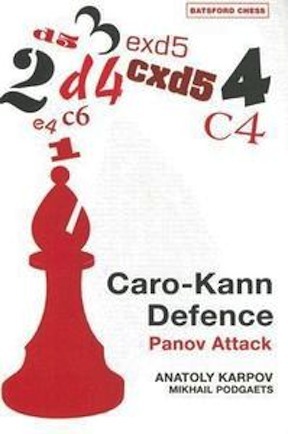Caro-Kann — Panov Attack
Anatoly Karpov, Mikhail Podgaets

I have often lamented the fact that there has been less quality literature written on the Caro-Kann than on any other major opening system. To make matters worse, any worthwhile book on the Caro that has been written is now hopelessly out of date. So, I was more than a bit excited when Caro-Kann Defence: Panov Attack appeared in my postbox.
With 276 pages covering just one anti-Caro system, this is a serious piece of work. And, as any serious study of this system should do, it takes a deep look at every intelligent black reply. The main variations that are considered:
1.e4 c6 2.d4 d5 3.exd5 cxd5 4.c4 Nf6 5.Nc3 Nc6 6.Nf3
1.e4 c6 2.d4 d5 3.exd5 cxd5 4.c4 Nf6 5.Nc3 Nc6 6.Bg5
1.e4 c6 2.d4 d5 3.exd5 cxd5 4.c4 Nf6 5.Nc3 g6!?
1.e4 c6 2.d4 d5 3.exd5 cxd5 4.c4 Nf6 5.Nc3 e6 6.Nf3 Nc6
1.e4 c6 2.d4 d5 3.exd5 cxd5 4.c4 Nf6 5.Nc3 e6 6.Nf3 Bb4
1.e4 c6 2.d4 d5 3.exd5 cxd5 4.c4 Nf6 5.Nc3 e6 6.Nf3 Be7
1.e4 c6 2.c4 is also given coverage since it can transpose to a proper Panov Attack after 2…d5 3.exd5 cxd5 4.d4. However, non-Panov lines like 2…e5, 2…e6, and 2…d5 are also given an amazing amount of attention.
I used to be well versed on Panov theory, but Caro-Kann Defence: Panov Attack made it clear that Im woefully behind the times. For example, 1.e4 c6 2.c4 e5 was something I always felt was a solid choice for those wishing to avoid mega-theory. Karpov and Podgaets smash my fantasy by pointing out that 3.Nf3! (all other White options on move three are given a thorough examination and turn out to be fine for Black) leaves Black with a rather cheerless position in all lines. On the other hand, I treated 1.e4 c6 2.c4 e6 with disdain the first time I saw it a billion years ago, and I still have the same view. Yet, this book makes it clear that White doesnt get more than a slight plus (Blacks a bit passive) after Blacks disgusting 2…e6.
Clearly, Blacks best response to 1.e4 c6 2.c4 is the natural 2…d5. Once again, the authors smacked me on the head with various surprises. First, I didnt know that 3.exd5 Nf6!? is a gambit that needs to be taken seriously — in fact, Black seems to have all the fun! But it turns out that 1.e4 c6 2.c4 d5 3.cxd5 (instead of 3.exd5) renders the gambit useless since 3…Nf6 is no longer sound.
Returning to 1.e4 c6 2.c4 d5 3.cxd5, the main line is 3…cxd5 4.exd5 Nf6 5.Bb5+ Nbd7 6.Nc3 g6 7.d4 Bg7 8.d6, which is fine for Black (if he knows his stuff!). Interestingly, Caro-Kann Defence: Panov Attack doesnt cover this position in the chapter on 1.e4 c6 2.c4, instead giving it from the move order: 1.e4 c6 2.d4 d5 3.exd5 cxd5 4.c4 Nf6 5.Nc3 g6!? 6.cxd5 Bg7 7.Bb5+ Nbd7 8.d6. Thus, instead of repeating this very topical position in the 1.e4 c6 2.c4 chapter, they make due with 4…Qxd5 5.Nc3 Qd8 6.d4 Nf6 7.Nf3 e6 8.Bd3, saying This position can be reached from the Panov Attack, Queens Gambit, Nimzo-Indian Defence, the 2.c3 Sicilian and many other opening schemes. Their analysis shows its quite playable, but it seems to me to be a tad sub-optimal — Black can get better versions of the classic isolated d-pawn position in the Panovs main lines.
Ive long felt that 1.e4 c6 2.d4 d5 3.exd5 cxd5 4.c4 Nf6 5.Nc3 g6!? was a great way for Black to fight for the initiative. Sadly, older theory always viewed it as being a bit dubious. Caro-Kann Defence: Panov Attack shows that its satisfactory, but demands more than a bit of knowledge from both sides. In a way, Karpov and Podgaets show that all of Blacks main choices are fully playable, but the most popular (and best) systems remain 1.e4 c6 2.d4 d5 3.exd5 cxd5 4.c4 Nf6 5.Nc3 e6 6.Nf3 Nc6 and 1.e4 c6 2.d4 d5 3.exd5 cxd5 4.c4 Nf6 5.Nc3 e6 6.Nf3 Bb4. Both have proven themselves at the highest levels, but the positions and ideas are vastly different. This is good news for Black, since he can choose whats most comfortable for his/her personal tastes.
Caro-Kann Defence: Panov Attack is the best book ever written on this anti-Caro system. Its a must own if you play the Caro-Kann as Black, and just as indispensable if you are a Panov Attack aficionado.
